
Tamara Vukovic is an Account Operations Manager at Acadia.
This article was updated on the 13th of March 2025.
At Acadia, we’re seeing a growing demand for more sophisticated reporting across multiple client accounts. Whether it’s general analytics or granular inventory data, Amazon’s Vendor Central offers a wide range of reports to help brands track performance and optimize their marketplace presence.
Mastering Vendor Central’s reporting tools isn’t just about pulling data—it’s about gaining the insights needed to strengthen your relationship with Amazon, improve catalog integrity, and drive profitability. From our experience, prioritizing the right reports has a tangible impact on channel success and sales revenue.
Since we first covered this in 2022, we’ve seen Amazon introduce new reporting features and enhancements. While the core structure of Vendor Central reports remains the same, several dashboards now feature expanded capabilities, with new reports refining data analysis.
One of the biggest shifts is Amazon’s move toward more advanced data management solutions, making it easier to aggregate and analyze performance across categories, regions, and time periods. Notably, Retail Analytics, Invoices (shortages), and Co-Op Invoices have been expanded to include more targeted reports, providing deeper, more precise insights.
With these updates in mind, let’s explore the most valuable Vendor Central reports and how they can help you maximize your brand’s potential on Amazon:
1) Analytics Report - Retail Analytics (Formerly Sales Diagnostics)
Retail Analytics is a comprehensive data dashboard within Amazon Vendor Central that provides vendors with critical insights into their sales performance, traffic, profitability, and inventory. Previously known as Sales Diagnostics, this tool has been upgraded with enhanced features that allow for more efficient data analysis and reporting.
Sales and Traffic reports show the major contributing KPIs such as your overall revenue, the number of units sold, and glance views. You can click through any of the headers on the table to sort by specific metrics and download the data.
RECENT ENHANCEMENTS
Retail Analytics Home Page
- Clickable metric summary cards for quick navigation
- Announcements section for real-time updates
- Direct links to the Help Center for guidance
- New feedback prompts to improve user experience

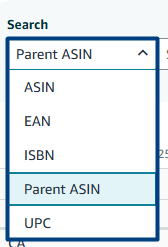
Customizable Data Views
The ability to customize reports by selecting or hiding columns enables your team to focus on the most relevant data, streamlining analysis and decision-making. This flexibility reduces time spent sorting through unnecessary information, allowing for a sharper focus on key metrics.
Additionally, by incorporating essential ASIN attributes—such as Parent ASIN, UPC, ISBN, EAN, and Model Number—across all relevant reports, you’ll have richer product insights readily available. This is particularly beneficial for teams managing extensive product catalogs or those requiring a more granular view of product performance.

Retail Analytics offers the flexibility to compare your data against either the previous period or year-over-year trends, providing deeper insights into performance.
The custom time frame—now expanded to 12 months from 6 months—allows for a more comprehensive view of long-term trends, helping clients make more informed strategic decisions.
Regional & Currency Aggregation
The new regional aggregation feature enables you to consolidate data across multiple regions, providing a comprehensive view of global performance. Coupled with the Currency Selector, you can seamlessly analyze sales data in your preferred currency, simplifying international operations.
You can now break down performance data by city, state, country, or postal code, unlocking granular insights into regional trends. When combined with a more granular time frame (e.g. daily, weekly), this powerful tool helps track performance over time and refine strategies at a local level.
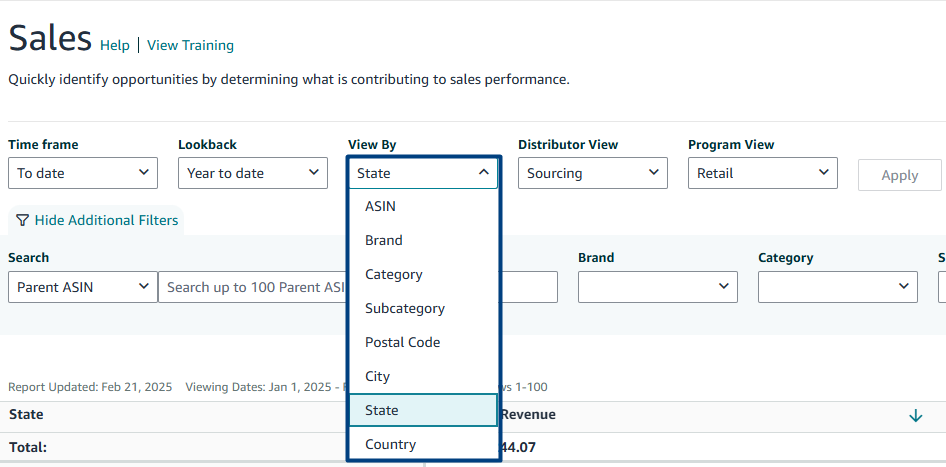
Real-Time Sales Reporting
The new Real-Time Sales Reporting Tool is a game changer for clients who rely on up-to-the-minute data to stay ahead.
Clients can access hourly sales data from the past 48 hours, quickly adapt to market changes, and maintain full visibility into their sales performance.

Other Dashboards within Retail Analytics
- Net PPM Dashboard: Analyze product profitability based on Net Pure Product Margin (Net PPM).
*Net PPM measures product profitability after the cost of goods, vendor funding, and sales discounts are accounted for.
**Net PPM = (Shipped Revenue - Shipped CCOGS + CCOGS - sales discount) / shipped revenue.
- Inventory and Forecasting: Track stock levels and identify sellable, unhealthy, or out-of-stock inventory (discussed below) and plan stock and order placement
- Catalog Dashboard: Monitor catalog quality with instant access to product details.
WHAT HAPPENED TO ARA PREMIUM?
In the past, ARA used to be available as a free Basic version or a Premium version which required over $30,000 per year.
Even after ARA Premium was phased out in 2022, many vendors still inquire about it. However, Amazon has replaced it with the free Retail Analytics dashboard, offering advanced reporting at no cost.
2) Operational Performance Report
The Operational Performance Report helps brands track and address potential issues that may arise during inventory transit to Amazon’s fulfillment centers. While occasional losses are expected, recurring operational challenges often indicate inefficiencies that need to be addressed.
This report is a powerful tool for monitoring performance, identifying infractions, and uncovering chargebacks. All of these insights are accessible within the Operational Performance Dashboard, giving brands a centralized hub to manage and improve their supply chain efficiency.
DEEP DIVE INTO SUPPLY CHAIN DATA
When Amazon signs on a new vendor as an ordering source, the vendor is expected to comply with all supply chain requirements that are set out in the Vendor Manual. While some brands are not aware of this standard, failing to comply with the requirements will generate an infraction.
The dashboard provides an intuitive way to explore data. Using the tabs at the top of the screen, you can analyze transactions by financial impact or chargeback subtype, allowing for targeted investigations.


On the right side of the screen, the Performance Summary displays key metrics for the selected time, including:
- Total chargebacks
- Number of affected ASINs
- Top non-compliant POs and ASINs
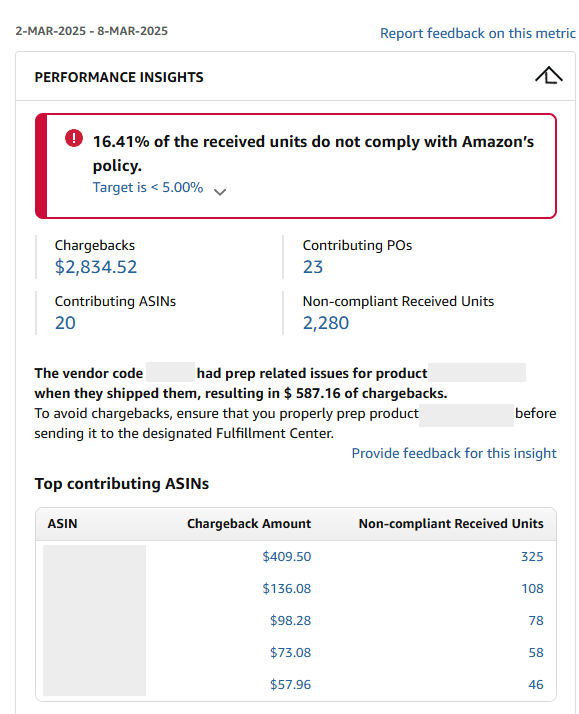

At the bottom of the page, you’ll find performance tips and recommendations to help improve compliance and minimize recurring issues. These insights can be instrumental in refining logistics strategies and avoiding costly mistakes.
For dispute management, the Defect Page provides a clear breakdown of charges along with detailed information. If eligible, you can dispute charges by submitting supporting evidence. Additionally, all data is available as an Excel file that can be exported for deeper analysis.

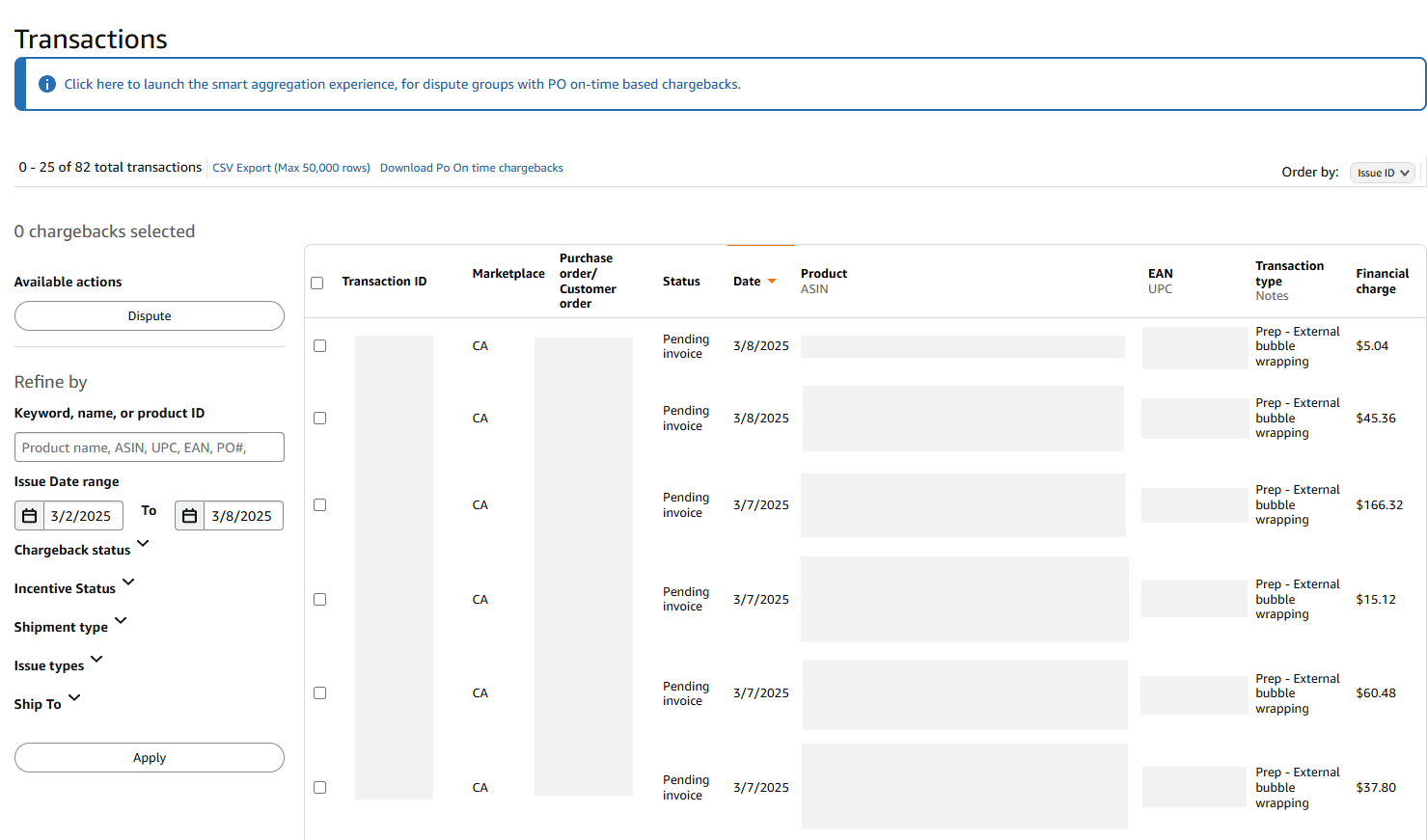
AMAZON INTRODUCES SMART AGGREGATION EXPERIENCE
Amazon has rolled out a new Smart Aggregation Experience to improve how vendors manage Purchase Order (PO) On-Time Accuracy chargebacks. As of April 30, 2024, chargebacks related to late or early deliveries are now grouped based on common attributes, simplifying the dispute process and reducing the volume of individual chargeback IDs.
What’s New?
- Grouped Chargebacks: Instead of handling multiple individual deductions, vendors will see chargebacks aggregated into dispute groups, making review and dispute resolution more efficient.
- 30-day Waiting Period: Chargebacks will be grouped and visible in Vendor Central after a 30-day waiting period, allowing vendors to review and dispute inaccuracies before deductions are applied.
- Improved Accuracy: This system ensures fairness by capping chargeback deductions to the verified amount Amazon has determined as valid.

Why This Matters
This update helps vendors streamline chargeback management, saving time and reducing administrative burdens. By consolidating disputes and providing a buffer period before deductions, Amazon aims to improve transparency and fairness in vendor chargeback processing.
For vendors, this means a more structured and predictable approach to managing PO On-Time infractions. To stay ahead, businesses should review their Vendor Central dashboards regularly and take advantage of the dispute window to address potential inaccuracies before deductions take effect.
3) Inventory Reports
Inventory reports are complex but essential for maintaining a well-balanced supply chain. They provide valuable insights into stock levels, demand forecasts, and potential inefficiencies, helping brands avoid costly inventory issues.
No major updates or structural changes have been made to the Inventory Report in recent years. However, Amazon introduced new search filters (EAN, ISBN, Parent ASIN) and custom columns to improve data segmentation.
At Acadia, we are testing external forecasting tools to improve accuracy while continuing to rely on Amazon's model.
Here’s what matters:
FORECASTING REPORTS
Forecasting reports assess future inventory needs based on projected sales, helping brands prevent overstock, understock, and out-of-stock (OOS) issues. By leveraging these reports, businesses can minimize lost sales due to inventory shortages.
Types of Forecasting Reports:
- Mean Forecast: Shows the best average estimate based on customer demand.
- P90 Forecast: This shows up when there is a 90% chance of Amazon buying the indicated demand level and 10% that they will buy more.
- P80 Forecast: This shows up when there is an 80% chance of Amazon buying the indicated demand level and 20% that they will buy more.
- P70 Forecast: This shows up when there is a 70% chance of Amazon buying the indicated demand level and 30% that they will buy more.
At Acadia, we use the Week 4 P90 Forecast Report at the ASIN level because it provides a reliable estimate of customer demand while allowing for adjustments based on supply chain lead times.
This report provides Amazon’s estimate that customer demand will stay at or below a specific value over the next four weeks. However, inventory lead times and individual client needs may require adjustments to the forecast type or timeframe.
INVENTORY REPORTS
An Inventory Report monitors the status of all products in a brand’s catalog, providing updates to help businesses identify and address critical inventory trends before they escalate.
To maximize its effectiveness, brands must track key performance indicators (KPIs), such as:
- Sellable On-Hand Units – Physical condition of the product as recorded in Amz inventory. Sellable inventory does not necessarily mean that it is available for sale on the Amazon website, only that it is not considered defective. However, since this report is not in real-time, it may not always match what customers see on the product details page.
- Unsellable Inventory – Inventory in Amazon fulfillment centers that is in unsellable condition Crucial for identifying damaged or defective items stored in Amazon’s fulfillment centers. A high volume of unsellable units may indicate issues in the packaging or preparation process, signaling the need for quality control improvements.
- Sourceable Product OOS – OOS rate on all products that have a source.
ADDITIONAL USEFUL METRICS
- Open Purchase Order Quantity – When analyzed alongside Sellable On-Hand Units, this metric can help vendors uncover bottlenecks that may be delaying shipments from fulfillment centers. Such delays can create a ripple effect, slowing down the entire supply chain.
- Unhealthy Units – These are excess units that remain unsold at the end of a forecasted demand period, which could point to overstocking or slow-moving inventory.
- Aged 90+ Days Sellable Units – This metric highlights units that have been sitting in inventory for over 90 days but are still sellable. Tracking this data can help brands identify slow-moving products and adjust their sales strategy before excess stock becomes a liability.
OPTIMIZING INVENTORY HEALTH: A CLIENT SUCCESS STORY
One Acadia client recently requested daily inventory health tracking, with a specific focus on monitoring the number of sellable on-hand units. Their goal was to identify why Amazon’s receiving process was taking longer than usual, leading to unexpected stockouts.
By analyzing the report, the brand could see exactly how many units of each ASIN were physically available in fulfillment centers at any given time. The data revealed delays in Amazon’s receiving process, which could have been caused by supply chain congestion or seasonal demand spikes.
To address the issue, the client took a proactive approach—internally coordinating with their carriers while leveraging Acadia to stay on top of their PDP status. By consistently tracking inventory levels and optimizing their supply chain strategy, they successfully reduced stockouts and increased the number of ASINs with available units over time.
Other Essential Reports Every Amazon Seller Should Be Using
1) INVOICE REPORTS
Invoice reports provide visibility into the status of invoices and processed amounts. The Amount Processed column reflects the total invoiced amount that has been processed, displayed as both an absolute figure and a percentage of the invoiced amount.

Recent enhancements in invoice management include:
- Detailed insights into potential root causes of price variances.
- Cost updates to track price adjustments over time.
- Event history showcasing cost changes throughout the purchase order lifecycle.
If you believe an invoice was incorrect due to a return, Co-Op agreement, price discrepancy, or shortage, you can dispute it through Dispute Management in Vendor Central.
2) FINANCIAL DASHBOARD & REPORTS
The Financial Dashboard is a comprehensive tool designed to simplify access to financial and payment data. This tool enables sellers to:
- Generate reports with customizable filters such as timeframe, store, and payee code.
- Track submitted financial requests.
- Download financial reports for further analysis.
3) VOICE OF THE CUSTOMER (VOTC)
The Voice of the Customer page serves as a central hub for customer feedback. This tool helps sellers optimize product listings and improve the overall customer experience by:
- Monitoring updates to the customer experience (CX) health of product offerings.
- Identifying and resolving product and listing issues based on customer feedback.
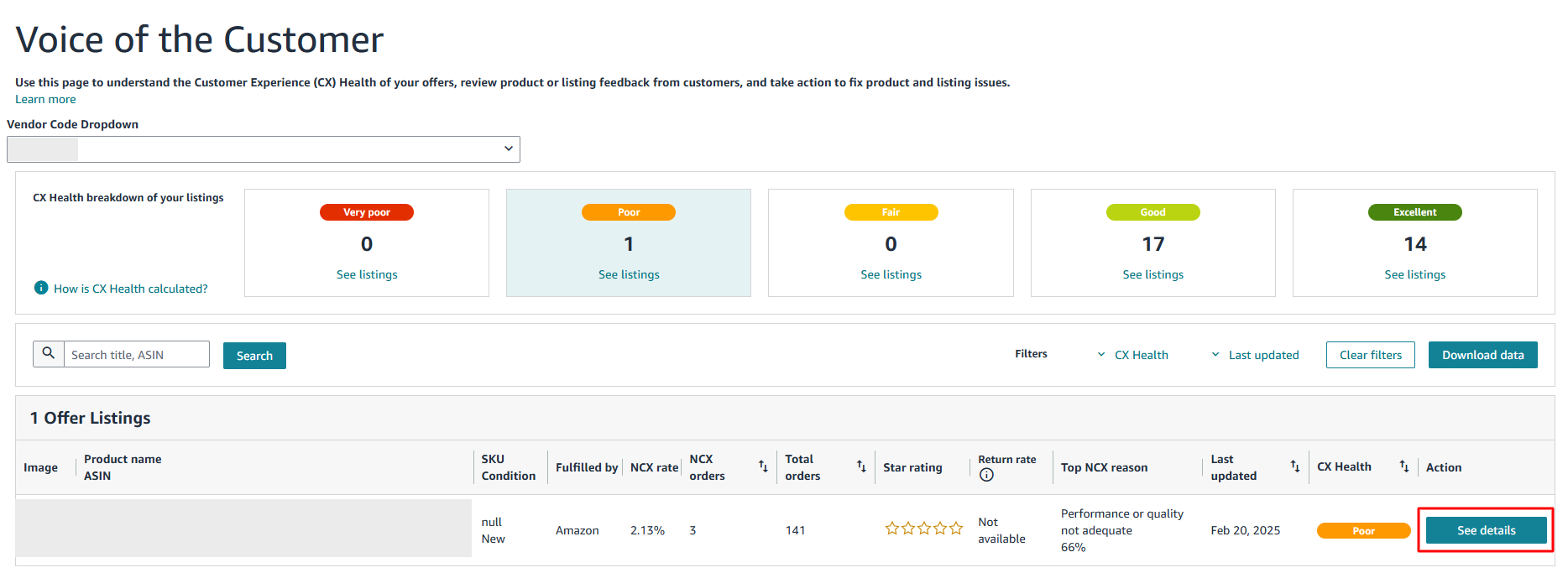
4) SUBSCRIBE & SAVE METRICS
For sellers using Subscribe & Save, tracking performance is essential to understanding customer retention and order trends. The Subscribe & Save Performance Dashboard provides:
- Performance data across daily, weekly, and monthly time frames.
- Downloadable reports for deeper analysis of subscription trends.

5. DIRECT FULFILLMENT REPORTS
Not all vendors use Direct Fulfillment (DF), but for those who do, these reports are critical in maintaining compliance and improving fulfillment efficiency.
Key insights include:
- Lead times, order processing speed, and missed shipments.
- Metrics such as cancellation rates, late shipments, and refunds.
- Daily Backlog and Aging Order reports for order flow management.
Regularly reviewing these reports can help brands optimize inventory management, minimize chargebacks, and maintain eligibility for Guaranteed Delivery badges, ultimately driving long-term growth.
6. BRAND ANALYTICS (ABA)
For vendors enrolled in the Brand Registry, Amazon provides Brand Analytics (ABA) to offer in-depth insights into sales, marketing, operations, and customer behavior. Unlike ARA (Amazon Retail Analytics), which is accessible to all vendors, ABA is exclusive to brand-registered sellers.
Key features of Brand Analytics include:
- Search Analytics: Understand how customers find products, including search popularity, click share, and conversion share.
- Market Basket Analysis: Discover which products are frequently purchased together.
- Repeat Purchase Behavior: Analyze repeat orders and track unique customer purchases.
Data in Brand Analytics is typically available within 72 hours after the close of a given period, allowing sellers to make timely, data-driven decisions.
The Bottom Line
Amazon continues to introduce new updates each month, with a strong focus on automation to minimize manual tasks like downloading and processing data.
Additionally, enhanced data management tools will improve efficiency, making it easier to handle large volumes of information seamlessly.
Stay ahead of these advancements—subscribe to our newsletter for the latest insights and strategies to help brands thrive in an omnichannel eCommerce landscape.
Get help managing your sales channel!
Request a consultation with Acadia's marketing team today.
